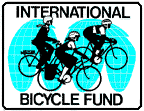The Bicyclist's Dilemma
In African Cities

![]() IBF is 100%
IBF is 100%
solar powered
![]()
by David Mozer
At first glance the bicycle seems ideal transportation for many in Africa cities: most are flat, trip distances are short and money for private motor vehicles and public transit systems is scarce. But generally bicycles are underutilized in Africa. The International Bicycle Fund's paper "The Bicyclist's Dilemma In African Cities," by David Mozer, examines this situation and some of the costs to individuals, society and the environment from not doing more to accommodate and encourage bicycle use.
The paper provides provocative reading. Mozer writes, "Not only has the income gap between the rich and poor increased in less developed countries, but so has the mobility gap. The cost of transportation construction has diverted funds and technical resources from other forms of investment which might benefit society as a whole. Foreign consultants propose transport planning models based on the use of motor vehicles exclusively. Typically, the reports justify large scale road construction projects, which means additional work for foreign consultants. An infrastructure has been designed to accommodate the elite's cars without any consideration of existing or potential bicycle and pedestrian traffic.
![]()
Table of Contents
- Introduction
- Urbanization (not included in online version)
- Land Use And Travel Patterns (not included in online version)
- Availability Of Equipment (not included in online version)
- Environmental Impacts (not included in online version)
- Energy Conservation (not included in online version)
- Infrastructure And Well Being (not included in online version)
- Economic Mechanisms (not included in online version)
- Attitudes (not included in online version)
- Culture (not included in online version)
- Safety (not included in online version)
- Trends (not included in online version)
- Policy Agenda (not included in online version)
Introduction
A survey of literature by Africa writers indicates that bicycles were a prominent mode of transport during the first half of the twentieth century. But for reasons that are not totally clear the bicycle and bicyclist don't fare well in the contemporary Africa city. Here are some general observations:
- Bicycles are used less in cities in Africa than in comparable cities in other developing economies.
- Bicycles are used less in most African urban centers than in many European and North American cities.
- Bicycle use in African cities has decreased significantly from thirty years ago, especially among adults.
- Low income people, numbering millions, walk in urban Africa.
- Africans show a substitution directly between walking and motor transport as income increases.
- Universities, the training ground of the future elite of a country and often the locale of heavy bicycle activity in the west, are generally located in or near urban areas in Africa, yet have virtually no bicycle use among their clientele.
- Though most African urban trips are less than 10 kilometers (km), urban transport resources have been concentrated on roads built to service the relatively few private automobiles.
- New investment to serve the short haul urban transport needs of low income groups has been nonexistent or has focused on capital intensive and foreign exchange intensive bus systems.
- Most governments are using road design standards that are neither bicycle-friendly nor pedestrian-friendly.
- Most African cities are neither people-friendly, bicycle-friendly nor environment-friendly.
- For reasons apparently independent of the actions of urban planners, the level of bicycle use seems to have halted the decreasing trends and has been on the increase in selected locations in recent years.
While theses observations are straightforward enough and with few exception hold true across sub-Saharan Africa, the underlying causes of these patterns are not always so clear. Care must be take to determine what is a valid generalization and where determinants differ significantly from city to city.
Home | About Us | Contact Us | Contributions | Economics | Education | Encouragement | Engineering | Environment | Bibliography | Essay Contest | Ibike Tours | Library | Links | Site Map | Search
![]()
The International Bicycle Fund is an independent, non-profit organization. Its primary purpose is to promote bicycle transportation. Most IBF projects and activities fall into one of four categories: planning and engineering, safety education, economic development assistance and promoting international understanding. IBF's objective is to create a sustainable, people-friendly environment by creating opportunities of the highest practicable quality for bicycle transportation. IBF is funded by private donation. Contributions are always welcome and are U.S. tax-deductible to the extent allowed by law.
![]()
![]() Please write if you have questions, comment, criticism, praise or
additional information for us, to report bad links, or if you would like to be
added to IBF's mailing list. (Also let us know how you found this site.)
Please write if you have questions, comment, criticism, praise or
additional information for us, to report bad links, or if you would like to be
added to IBF's mailing list. (Also let us know how you found this site.)
